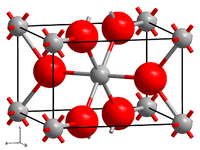Vanadium (IV) oxide
| Crystal structure | ||||||||||||||||
|---|---|---|---|---|---|---|---|---|---|---|---|---|---|---|---|---|

|
||||||||||||||||
| __ V 4+ __ O 2− | ||||||||||||||||
| General | ||||||||||||||||
| Surname | Vanadium (IV) oxide | |||||||||||||||
| other names |
Vanadium dioxide |
|||||||||||||||
| Ratio formula | VO 2 | |||||||||||||||
| Brief description |
dark green black solid |
|||||||||||||||
| External identifiers / databases | ||||||||||||||||
|
||||||||||||||||
| properties | ||||||||||||||||
| Molar mass | 82.94 g mol −1 | |||||||||||||||
| Physical state |
firmly |
|||||||||||||||
| density |
4.34 g cm −3 |
|||||||||||||||
| Melting point |
1970 ° C |
|||||||||||||||
| solubility |
almost insoluble in water |
|||||||||||||||
| safety instructions | ||||||||||||||||
|
||||||||||||||||
| As far as possible and customary, SI units are used. Unless otherwise noted, the data given apply to standard conditions . | ||||||||||||||||
Vanadium (IV) oxide is one of several oxides of vanadium . It is a high melting point, black solid. Vanadium (IV) oxide plays an important role in the catalytic conversion of sulfur dioxide to sulfur trioxide in the contact process for sulfuric acid production .
Extraction and presentation
Vanadium (IV) oxide can be obtained from vanadium (V) oxide . When heated with weak reducing agents such as carbon monoxide , sulfur dioxide or oxalic acid, this is converted into vanadium (IV) oxide:
properties
Physical Properties
Vanadium (IV) oxide has two different modifications that transform into each other at 70 ° C. Below 70 ° C it has a distorted rutile structure in which two vanadium atoms are linked by a bond. Above 70 ° C these bonds break. An undistorted rutile structure is formed. At the same time the electrical conductivity and the paramagnetism increase significantly.
More recent investigations on single-crystal nanowires of vanadium (IV) oxide have shown that at 65.0 ° C there is a triple point of one metallic and two insulating phases of the metal oxide. Only the slightest changes in these conditions were sufficient to stabilize only a single phase at a time, with the changes taking place within a few picoseconds. In the metallic high temperature (rutile, R) phase all chains are straight and regular, while in the non-conductive low temperature phase ( monoclinic M1) every chain dimerizes. There are also two other known isolating phases: a monoclinic M2, in which only one set of chains dimerizes, and a triclinic , which is an intermediate of M1 and M2. The presence of both M1 and M2, with similar dielectric properties but different magnetic properties, places limitations on the previous theory of metal-insulator junctions. For example, it rules out a pure Peierls mechanism .
Chemical properties
Like titanium (IV) oxide , vanadium (IV) oxide is amphoteric ; it dissolves in both strong acids and strong bases. With acids it forms [VO (H 2 O) 5 ] 2+ ions, with bases it forms [VO (OH) 3 ] - ions.
use
During sulfuric acid production in the contact process, vanadium (IV) oxide is formed by transferring an oxygen ion from the vanadium (V) oxide to the sulfur dioxide. The vanadium (V) oxide used is recovered by oxidation with oxygen .
Due to the conversion between the different phases, vanadium (IV) oxide can be used as an optical switch. At 68 ° C, it changes from an infrared transparent and semiconducting state to a reflective and conductive state in a very short time . By adding small amounts of tungsten to vanadium dioxide, the transformation temperature can be reduced to around 29 ° C, which makes the oxide suitable for the heat-resistant coating of glass surfaces.
Individual evidence
- ↑ a b c d Entry on vanadium (IV) oxide in the GESTIS substance database of the IFA , accessed on July 6, 2008(JavaScript required) .
- ↑ a b Datasheet Vanadium (IV) oxide from Sigma-Aldrich , accessed on April 25, 2011 ( PDF ).
- ↑ Georg Brauer: Low Vanadinoxyde: . In: Handbook of Preparative Inorganic Chemistry . Ferdinand Enke Verlag, Stuttgart 1954, p. 951 .
- ↑ Wissenschaft-aktuell: Complicated phase changes: where three states meet
- ↑ Jae Hyung Park, Jim M. Coy, T. Serkan Kasirga, Chunming Huang, Zaiyao Fei, Scott Hunter, David H. Cobden: Measurement of a solid-state triple point at the metal – insulator transition in VO 2 . In: Nature. 500, 2013, pp. 431-434, doi : 10.1038 / nature12425 .
- ^ Leonard C. Feldman: Timing nature's fastest optical shutter , physorg.com, April 7, 2005.
- ↑ Spectrum Direct : Glass coating leaves the heat outside. Report from August 9, 2004.
- ^ Troy D. Manning and Ivan P. Parkin: "Atmospheric pressure chemical vapor deposition of tungsten doped vanadium (IV) oxide from VOCl 3 , water and WCl 6 ", Journal of Materials Chemistry 2004 , 14 , 2554-2559; doi : 10.1039 / b403576n .
literature
- AF Holleman , E. Wiberg , N. Wiberg : Textbook of Inorganic Chemistry . 102nd edition. Walter de Gruyter, Berlin 2007, ISBN 978-3-11-017770-1 , p. 1548.





